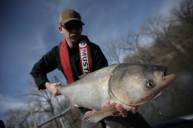We have tons of invasive species problems here in the United States. Between feral hogs in Texas and Burmese pythons in Florida, we have our fair share of destructive animals wreaking havoc on our ecosystems. It's these larger, land-dwelling animals that come to mind when discussing the damage caused by unwelcome animals, but we often forget about an aquatic force just as strong in the Asian carp.
Technically, the term "Asian carp" is something of an umbrella term for several invasive fish species that aren't native to North America. Underneath that umbrella are common carp (Cyprinus carpio), grass carp (Ctenopharyngodon idella), silver carp (hypophthalmichthys molitrix), black carp (Mylopharyngodon piceus), and bighead carp (hypophthalmichthys nobilis). Most of these fish grow fairly large in size, spawn quickly and do far more harm in our waters than good, as they fiercely compete with native fish for food.
It's difficult to measure just how much damage these fish cause, but they're undoubtedly a major problem. When you see a video like this one put together by the Kentucky Department of Fish & Wildlife Resources, during which officials electroshock a river and send thousands of fish airborne, we just how dire this situation is.
Yikes, talk about a carp problem! Unfortunately, this aquatic invasive species is already quite common throughout the Mississippi River System, the Ohio River, the Missouri River and the Illinois River. From those large waterways, the different species of Asian carp have spread to countless other lakes, streams, wetlands, and watersheds, raising major concerns for native species. These fish have only been here for about 50 years and have already reproduced enough to create a display this alarming, which answers any question you may have as to why agencies like the U.S. Fish and Wildlife Service and the U.S. Geological Survey are feeling pressured to come up with a remedy.
Most of these fish were imported from Asia sometime in the 1970s to keep commercial ponds clean, as they're bottom feeders, but they've spread far too rapidly, especially to the Great Lakes where grass carp reside in large numbers. The U.S. Army Corps of Engineers is one of the organizations currently being tasked with protecting the Great Lakes, where they've already built locks and dams. Additionally because of their tendency to jump as you see here, these fish present a hazard to boaters.
However, there is some good news for anglers, especially those who enjoy bowfishing, as most wildlife agencies are allowing people to take as many of these carp as they can. It may not make a huge dent, but we see anything done to stop the spread of Asian carp as a good thing. If you're game to rig up a bow, you could help your local fisheries by taking a shot at some of these fish!
For more outdoor content from Travis Smola, be sure to follow him on Twitter and check out his Geocaching and Outdoors with Travis YouTube channels.




